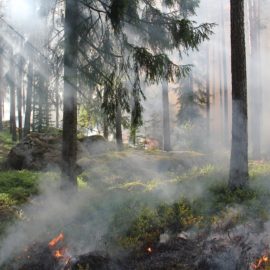
Fire is an equalizer. A needed pumping station was turned off due to a fire.
Dubbed the “crown jewel” of Ascension Parish’s drainage system, the Marvin J. Braud Pumping Station was completely shut for a little more than eight hours on a rainy day in late December, allowing waters to rise for a time but not flood any structures, a preliminary analysis has found. Three of the station’s seven pumps caught fire internally after an air pressure system failed and a key alarm didn’t immediately signal personnel working at the isolated facility in the McElroy Swamp, according to the parish analysis. Two weeks after the late morning fires of Dec. 30, the station remained only partially operational on Friday. Roy Savoy, Ascension’s public works director, said five pumps were available for use after one them came online earlier last week following repairs.
nola.com
Sounds like us with our pumping stations but our pumps are older.
This close call has brought to light new concerns about a usually reliable station built in the early 1990s that could now require some potentially costly fixes. Those fixes include the need to modernize its safety and control systems, improve its maintenance and worker training programs, and, perhaps, add more workers at the station and eventually replace the aging original five enormous pumps at the station. It now has seven. Parish President Clint Cointment said replacement parts for the oldest pumps are becoming harder to find and will eventually need to be manufactured. “We really need to start a multi-year budget, start budgeting for new engines in this station,” Cointment told the Parish Council this past week. “They are not cheap. We need to start putting, allocating a certain amount — and I would suggest starting that next year — and start replacing these five engines.” The parish spent more than $13 million between 2011 and 2013 to add a sixth pump and to build the structural bays that house that pump and a seventh pump that came later at additional cost.
That sounds so familiar.
The fire happened while the pumps were running to combat a rain storm that ended up dropping four to five inches, parish officials said. Hidden under large metal cowlings installed when the pumps were still exposed to the elements, the fires started late morning on Dec. 30 shortly after the station’s mechanic had left. He had been called north to another pump station in Galvez to address an urgent problem there, parish officials said. A second mechanic was in route to the Marvin Braud site, but the quick efforts of the station’s three remaining workers, once they realized what was happening, got control of the fires. They used as many 18 fire extinguishers, parish officials said. Later local firefighters put out what remained of the fire at the remote station in low-lying swamp southeast of Sorrento and Airline Highway, parish officials said. The fires were out completely in about 35 minutes.
The parish is conducting an investigation but wants local leaders to look at the problem.
While parish drainage officials continue their examination of what happened, Cointment has said he would like local industry leaders to take a look at the station’s systems. Newly elected drainage chairwoman Councilwoman Teri Casso has also asked her former council colleague, Bill Dawson, who spent his career in industry and who now works for the parish, to take a closer look at what happened, while longtime Councilman Dempsey Lambert wants more personnel at the station. Parish officials could not yet say what it will cost to make all the repairs, though officials said the parish’s insurer is involved.
These are not the only pumps but this is the the biggest and most essential one.
Eastern Ascension has other parish pumps, including at Henderson Bayou in Galvez and at Bayou Conway in Sorrento, but also has areas, like much of Prairieville and Burnside, that aren’t affected by pumps and drain by gravity alone. The Marvin Braud station, however, does the heavy lifting for the remainder of the east bank, draining 76 square miles of eastern Ascension, including Gonzales, St. Amant and parts of southern Prairieville and the Sorrento area east of Airline. Over the past 15 years or so, the station has been the focus of additional investment after its initial construction. That has included the two new pumps that brought the total to seven, protections to make the station more resilient from hurricanes and other severe weather, and other steps to make the station more efficient at moving water and handling debris that heads into the pumps’ intakes. But the fire has underlined that parish officials have more to do to bring the station into the modern times, officials said.
The labeling of the station is old making the thought that updates are needed.
Ascension Parish Councilman Chase Melancon, the outgoing drainage chairman at the time of the fire, said he was at the station about 15 to 20 minutes after the fire started between 11:40 a.m. and 11:45 a.m. After that visit inside the station’s building, Melancon said, he recognized its safety and control systems are out of date, labeling them in a recent meeting technology from 1995. Melancon, who works as a production manager in a local chemical plant, said the pump station operation is primarily manually operated. He said it doesn’t appear to have enough backups, early warning systems, prepared troubleshooting methods and regular maintenance checks to avoid the kind of failure that happened Dec. 30. “There’s not a lot of automated systems on the machine, you know, automated systems that are put in place to protect them,” he said.
The parish has visited other parishes and states to learn about drainage.
Cointment administration officials have visited Jefferson Parish and Houston, Texas, in recent years for ideas on how to improve Ascension’s drainage works. In Jefferson, the parish’s system of 174 pumps have both manual and remote control, with each pump having its own touchscreen for operation and monitoring, that parish’s drainage director said. The system has 24 major stations and 50 interior stations to route storm water from Louisiana’s most populous parish into the Mississippi River and Lake Pontchartrain. Those stations have systems that automatically cut off equipment if early warning signs arise, said Ben Levine, the drainage director. Levine said these upgrades have come over more than 20 years, even before the disastrous flooding in Jefferson during Hurricane Katrina in 2005, and have built in redundancy and methods to isolate breakdowns so they don’t have a wider effect. “If there is an issue, we lose one pump and not a station. We always make sure redundancy is the name of the game, and we isolate each system so it is independent,” Levine said.
The cause has been found so now a fix can be proposed.
In Ascension, the air pressure loss blamed for the fires affected inflatable clutches. With appropriate air pressure inside them, these clutches squeeze down so that the pump motors can engage the pump impellers, making the big fan blades spin and move water. With the loss of air pressure from a single system, the pump motors and the impellers on all seven pumps lost pressure and didn’t engage. The resulting friction from equipment spinning at thousands of revolutions per minute caused fires inside three pumps, officials speculated. President Cointment said more pumps didn’t catch fire because workers acted quickly to manually shut them down. Six of seven were running at the time. Melancon said the pump station should have automatic sensors and controls that would shut the pumps when that kind of pressure loss happens and procedures to ensure the alarm that failed last month was working. “A big part is modernizing and installing these safeguards but equally as important is having a program where these safeguards are tested,” he said. Councilman Dal Waguespack said more training of workers could help in the interim before costly upgrades do occur.
Amazing how so many have the same drainage problems.



